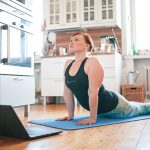Your cart is currently empty!
Farnham Pilates weekly blog – get ski-fit!

Get Ski fit – Pilates Exercises to get ready for Skiing
[Week 1]
Pain and injury-free skiing for all the family with Pilates
Five-minute
read
I am a keen skier so I appreciate that getting your body ready for your ski
trip really can help you avoid injury, get stronger so you can do more runs
faster or with more confidence, as well as prevent general ski-related aches
and pains. This goes for everyone in the family including children; I notice a
great difference in my children’s improvement and tiredness levels by getting
us to do a few exercises before we go.
So, if you are planning a weekend or Easter ski break, Pilates can help you
avoid injury, ski without aches and pains, and have a better time. This week I
make a case for doing ski prep exercises, but I’ll follow this up over the next
couple of weeks with exercise routines.
Ski preparation – How can Pilates help prepare you for skiing?
Skiing uses lots of muscles that most of us don’t use a great deal in our everyday lives; if these muscles are prepared, they are less likely to pull or tear i.e. quads, gluts, core and obliques.
Pilates will…..
- Improve body awareness and alignment to reduce risk of injury.
- Strengthen and increase endurance of the right muscles by isolating movements.
- Improve core strength, balance and stabilise the joints to create better controlled slalom turns.
- Mobilise joints so if there is a fall you are less likely to injury yourself.
- Improve fitness and cardio levels for during and post ski activities.
- Reduce aches and fatigue to enable you to ski longer during the day.
Preventing injury
Taking care to strengthen, stabilise and mobilise the joints that twist
and turn during skiing can help prevent injuries on knees, neck, wrists,
ankles, shoulders and muscular problems. Statistics show falls are a high risk
for women and children skiers, while men tend to suffer from injuries as a
result of high speeds like muscle fatigue, head and neck injuries, neck sprain,
and shoulder and medial ligament injuries. Snowboarding tends to cause ankle
and wrist injuries. However, for every thousand people on the ski slopes per
day, only two to four will sustain an injury that requires medical attention,
that’s a risk of only 0.2-0.4%. However it may not only bring your holiday to
an abrupt end but could also prove expensive in terms of medical treatment.
Your exercise programme needs to have key elements for Skiing –
Brenna Kelleher, a former NCAA ski racer and ski instructor and guide explains
that each turn down a slope is like a sprint that engages leg, back and core
muscles. While an aerobic base can help skiers recover faster the key for
preparing your body is to focus on cardio intensity with core strength. Pilates
exercises combines and improves the following elements –
- Your alignment and posture.
- Cardio endurance – for an aerobic base (essential for recovery), a high lactate threshold (so you can ski longer before you feel the burn) and lactate power (which provides the oomph you need for intense efforts).
- Strengthen quads and back muscles especially if you are a beginner in a snow plough position.
- Increase strength and endurance of legs, buttocks and hips to mimic skiing to help create precision of movement, coordination and power i.e. squats on the vibration plate.
- Improve your balance and stability with one-leg emphasis exercises.
- Improve spinal mobility and oblique strength for rotations for turning and twisting at speed.
- Strengthen your core abdominals.
- Improve coordination and body awareness for speed accuracy (so that you can respond quickly when avoiding another skier or ice).
- Improve joint mobility and flexibility like ankles, knees and hips. (Feet influence a skier’s alignment and his or her ability to execute powerful movement. Edging and applying pressure to carve a turn and stay in control starts with the feet.)
Your ski exercise preparation routine –
Start to prepare six weeks in advance with the
following exercises and sign up to do videos at home like our online
Pilates program (www.pilatescommunity.co.uk) and your ski trip
will be more comfortable, easier on your body and your children will be
less tired and have more fun.
I recommend an increase in a weekly schedule of exercise as follows :
- Daily moderate in small chunks of 30-60 mins – obvious things include cardio like fast walking, take the stairs, cycle, walk to work
- Weekly cardio moderate to vigorous exercise 3-4 times intense 20 mins (cycle, jog, swim, dance, football)
- Weekly mobilise and stretch routine 2-3 times a week for 10-20 mins like yoga or Pilates.
- Increase your stamina and repetitions over a six-week programme. Build slowly, increase your speed and the mix of exercise.
To get
strong join our 30 days of Pilates
only £9.99 or the Pilates membership try
1 month get access to ski fit videos for only £11 per month, or full access for
all videos for £49 for six months or
£110 for annual membership.
Next week… Next week we look at the basics of how to exercise along with some stretches and vital balance exercises.
Squeeze and breathe,
Love Hannah x